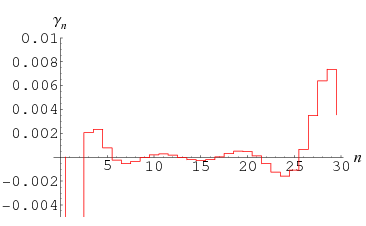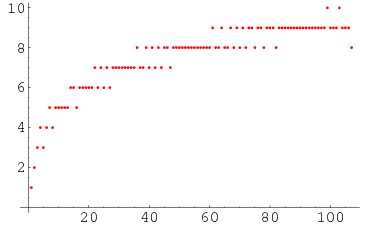


 تاريخ الرياضيات
تاريخ الرياضيات
 الرياضيات في الحضارات المختلفة
الرياضيات في الحضارات المختلفة 
 الرياضيات المتقطعة
الرياضيات المتقطعة
 الجبر
الجبر
 الهندسة
الهندسة 
 المعادلات التفاضلية و التكاملية
المعادلات التفاضلية و التكاملية 
 التحليل
التحليل
 علماء الرياضيات
علماء الرياضيات |
Read More
Date: 20-12-2020
Date: 28-10-2020
Date: 14-12-2019
|
Expanding the Riemann zeta function about  gives
gives
 |
(1) |
(Havil 2003, p. 118), where the constants
![gamma_n=lim_(m->infty)[sum_(k=1)^m((lnk)^n)/k-((lnm)^(n+1))/(n+1)]](http://mathworld.wolfram.com/images/equations/StieltjesConstants/NumberedEquation2.gif) |
(2) |
are known as Stieltjes constants.
Another sum that can be used to define the constants is
 |
(3) |
These constants are returned by the Wolfram Language function StieltjesGamma[n].
A generalization  takes
takes  as the coefficient of
as the coefficient of  is the Laurent series of the Hurwitz zeta function
is the Laurent series of the Hurwitz zeta function  about
about  . These generalized Stieltjes constants are implemented in the Wolfram Language as StieltjesGamma[n, a].
. These generalized Stieltjes constants are implemented in the Wolfram Language as StieltjesGamma[n, a].
The case  gives the usual Euler-Mascheroni constant
gives the usual Euler-Mascheroni constant
 |
(4) |
A limit formula for  is given by
is given by
![gamma_1=-lim_(y->infty)y{y+I[zeta(1+i/y)]},](http://mathworld.wolfram.com/images/equations/StieltjesConstants/NumberedEquation5.gif) |
(5) |
where ![I[z]](http://mathworld.wolfram.com/images/equations/StieltjesConstants/Inline9.gif) is the imaginary part and
is the imaginary part and  is the Riemann zeta function.
is the Riemann zeta function.
An alternative definition is given by absorbing the coefficient of  into the constant,
into the constant,
 |
(6) |
(e.g., Hardy 1912, Kluyver 1927).
The Stieltjes constants are also given by
![gamma_n=lim_(z->1)[(-1)^nzeta^((n))(z)-(n!)/((z-1)^(n+1))].](http://mathworld.wolfram.com/images/equations/StieltjesConstants/NumberedEquation7.gif) |
(7) |


Plots of the values of the Stieltjes constants as a function of  are illustrated above (Kreminski). The first few numerical values are given in the following table.
are illustrated above (Kreminski). The first few numerical values are given in the following table.
 |
OEIS |  |
| 0 | A001620 | 0.5772156649 |
| 1 | A082633 |  |
| 2 | A086279 |  |
| 3 | A086280 | 0.002053834420 |
| 4 | A086281 | 0.002325370065 |
| 5 | A086282 | 0.0007933238173 |

Briggs (1955-1956) proved that there infinitely many  of each sign. The signs of
of each sign. The signs of  for
for  , 1, ... are 1,
, 1, ... are 1,  ,
,  , 1, 1, 1,
, 1, 1, 1,  ,
,  ,
,  ,
,  , ... (OEIS A114523), and the run lengths of consecutive signs are 1, 2, 3, 4, 3, 4, 5, 4, 5, 5, 5, ... (OEIS A114524). A plot of run lengths is shown above.
, ... (OEIS A114523), and the run lengths of consecutive signs are 1, 2, 3, 4, 3, 4, 5, 4, 5, 5, 5, ... (OEIS A114524). A plot of run lengths is shown above.
Berndt (1972) gave upper bounds of
 |
(8) |
However, these bounds are extremely weak. A stronger bound is given by
 |
(9) |
for  (Matsuoka 1985).
(Matsuoka 1985).
Vacca (1910) proved that the Euler-Mascheroni constant may be expressed as
 |
(10) |
where  is the floor function and the lg function
is the floor function and the lg function  is the logarithm to base 2. Hardy (1912) derived the formula
is the logarithm to base 2. Hardy (1912) derived the formula
 |
(11) |
from Vacca's expression.
Kluyver (1927) gave similar series for  valid for all
valid for all  ,
,
 |
(12) |
where  is a Bernoulli polynomial. However, this series converges extremely slowly, requiring more than
is a Bernoulli polynomial. However, this series converges extremely slowly, requiring more than  terms to get two digits of
terms to get two digits of  and many more for higher order
and many more for higher order  .
.
 can also be expressed as a single sum using
can also be expressed as a single sum using
 |
(13) |
 also appears in the asymptotic expansion of the sum
also appears in the asymptotic expansion of the sum
 |
(14) |
where  was called
was called  and given incorrectly by Ellision and Mendès-France (1975) (and the error was subsequently reproduced by Le Lionnais 1983, p. 47). The exact form of (14) is given by
and given incorrectly by Ellision and Mendès-France (1975) (and the error was subsequently reproduced by Le Lionnais 1983, p. 47). The exact form of (14) is given by
 |
(15) |
where  is a harmonic number and
is a harmonic number and  is a generalized Stieltjes constant.
is a generalized Stieltjes constant.
A set of constants related to  is
is
![delta_n=lim_(m->infty)[sum_(k=1)^m(lnk)^n-int_1^m(lnx)^ndx-1/2(lnm)^n]](http://mathworld.wolfram.com/images/equations/StieltjesConstants/NumberedEquation16.gif) |
(16) |
(Sitaramachandrarao 1986, Lehmer 1988).
The Stieltjes constants also satisfy the beautiful sum
![sum_(k=0)^infty(gamma_(k+n))/(k!)=(-1)^n[n!+zeta^((n))(0)]](http://mathworld.wolfram.com/images/equations/StieltjesConstants/NumberedEquation17.gif) |
(17) |
(O. Marichev, pers. comm., 2008).
REFERENCES:
Berndt, B. C. "On the Hurwitz Zeta-Function." Rocky Mountain J. Math. 2, 151-157, 1972.
Bohman, J. and Fröberg, C.-E. "The Stieltjes Function--Definitions and Properties." Math. Comput. 51, 281-289, 1988.
Briggs, W. E. "Some Constants Associated with the Riemann Zeta-Function." Mich. Math. J. 3, 117-121, 1955-1956.
Coffey, M. W. "New Results on the Stieltjes Constants: Asymptotic and Exact Evaluation." J. Math. Anal. Appl. 317, 603-612, 2006.
Coffey, M. W. "New Summation Relations for the Stieltjes Constants." Proc. Roy. Soc. A 462, 2563-2573, 2006.
Ellison, W. J. and Mendès-France, M. Les nombres premiers. Paris: Hermann, 1975.
Finch, S. R. "Stieltjes Constants." §2.21 in Mathematical Constants. Cambridge, England: Cambridge University Press, pp. 166-171, 2003.
Hardy, G. H. "Note on Dr. Vacca's Series for  ." Quart. J. Pure Appl. Math. 43, 215-216, 1912.
." Quart. J. Pure Appl. Math. 43, 215-216, 1912.
Hardy, G. H. and Wright, E. M. "The Behavior of  when
when  ." §17.3 in An Introduction to the Theory of Numbers, 5th ed. Oxford, England: Clarendon Press, pp. 246-247, 1979.
." §17.3 in An Introduction to the Theory of Numbers, 5th ed. Oxford, England: Clarendon Press, pp. 246-247, 1979.
Havil, J. Gamma: Exploring Euler's Constant. Princeton, NJ: Princeton University Press, 2003.
Kluyver, J. C. "On Certain Series of Mr. Hardy." Quart. J. Pure Appl. Math. 50, 185-192, 1927.
Knopfmacher, J. "Generalised Euler Constants." Proc. Edinburgh Math. Soc. 21, 25-32, 1978.
Kreminski, R. "Newton-Cotes Integration for Approximating Stieltjes (Generalized Euler) Constants." Math. Comput. 72, 1379-1397, 2003.
Kreminski, R. "This Site Will Archive Some Stieltjes-Related Computational Work..." http://www.tamu-commerce.edu/math/FACULTY/KREMIN/stieltjesrelated/.
Kreminski, R. "This Page Displays Work in Progress by Rick Kreminski." http://www.tamu-commerce.edu/math/FACULTY/KREMIN/stieltjes/stieltjestestpage.html.
Kreminski, R. "Gammas 1 to 12 to 6900 Digits." http://www.tamu-commerce.edu/math/FACULTY/KREMIN/stieltjesrelated/gammas1to12/.
Lammel, E. "Ein Beweis dass die Riemannsche Zetafunktion  is
is  keine Nullstelle besitzt." Univ. Nac. Tucmán Rev. Ser. A 16, 209-217, 1966.
keine Nullstelle besitzt." Univ. Nac. Tucmán Rev. Ser. A 16, 209-217, 1966.
Le Lionnais, F. Les nombres remarquables. Paris: Hermann, p. 47, 1983.
Lehmer, D. H. "The Sum of Like Powers of the Zeros of the Riemann Zeta Function." Math. Comput. 50, 265-273, 1988.
Liang, J. J. Y. and Todd, J. "The Stieltjes Constants." J. Res. Nat. Bur. Standards--Math. Sci. 76B, 161-178, 1972.
Matsuoka, Y. "Generalized Euler Constants Associated with the Riemann Zeta Function." In Number Theory and Combinatorics. Japan 1984 (Tokyo, Okayama and Kyoto, 1984). Singapore: World Scientific, pp. 279-295, 1985.
Plouffe, S. "Stieltjes Constants from 0 to 78, to 256 Digits Each." http://pi.lacim.uqam.ca/piDATA/stieltjesgamma.txt.
Sitaramachandrarao, R. "Maclaurin Coefficients of the Riemann Zeta Function." Abstracts Amer. Math. Soc. 7, 280, 1986.
Sloane, N. J. A. Sequences A001620/M3755, A082633, A086279, A086280, A086281, A086282, A114523, and A114524 in "The On-Line Encyclopedia of Integer Sequences."
Vacca, G. "A New Series for the Eulerian Constant." Quart. J. Pure Appl. Math. 41, 363-368, 1910.



|
|
|
|
دخلت غرفة فنسيت ماذا تريد من داخلها.. خبير يفسر الحالة
|
|
|
|
|
|
|
ثورة طبية.. ابتكار أصغر جهاز لتنظيم ضربات القلب في العالم
|
|
|
|
|
|
|
العتبة العباسية المقدسة تستعد لإطلاق الحفل المركزي لتخرج طلبة الجامعات العراقية
|
|
|